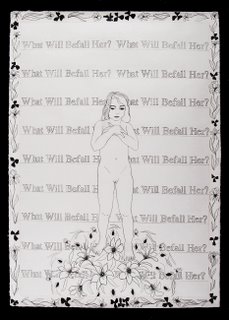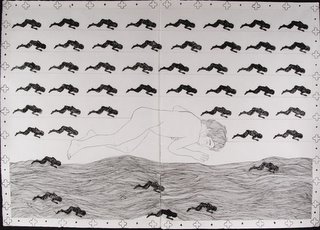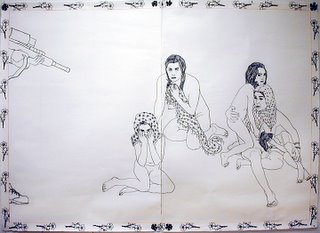Friday, January 13, 2006
Prayer Series Statement
Fahimeh Vahdat email address
Art becomes transcendent as it progressively lets go of a self-directed focus, extending outwards to family, friends, community and to God. Prayer can be part of such a voyage. In prayer we have the opportunity to rise above prayers for your direct self-interest, and to concentrate on others who are in need. Prayer for Daughters, Prayer for Detachment, Prayer for the Earth, are visual meditations on specific themes.
The voiced prayer, the thought prayer, the intoned prayer, are no different, in my mind, than is a prayer I may paint. As with music, which often better expresses our meanings than do words, visual abstraction, including symbols, has a superior potential for universal communication. Color relationships, texture and symbols are not bound by cultural or ethnic lines. The meaning and intensity of a visual image is available to all.
My approach involves immersing myself in my chosen materials, currently oil and encaustic on wooden panels, allowing symbols to arise as I successively generate, layer, veil and rework the images. In effect, the painting documents my mind’s eye in the process of meditation as I interact with the materials. The paintings are spontaneous in the sense that they ride the moment of my awareness and are not pre-designed. At the same time, the finished work may be structured like a blanket in which many overlapping stories are woven.
Copyright © 2006 Fahimeh Vahdat
Art becomes transcendent as it progressively lets go of a self-directed focus, extending outwards to family, friends, community and to God. Prayer can be part of such a voyage. In prayer we have the opportunity to rise above prayers for your direct self-interest, and to concentrate on others who are in need. Prayer for Daughters, Prayer for Detachment, Prayer for the Earth, are visual meditations on specific themes.
The voiced prayer, the thought prayer, the intoned prayer, are no different, in my mind, than is a prayer I may paint. As with music, which often better expresses our meanings than do words, visual abstraction, including symbols, has a superior potential for universal communication. Color relationships, texture and symbols are not bound by cultural or ethnic lines. The meaning and intensity of a visual image is available to all.
My approach involves immersing myself in my chosen materials, currently oil and encaustic on wooden panels, allowing symbols to arise as I successively generate, layer, veil and rework the images. In effect, the painting documents my mind’s eye in the process of meditation as I interact with the materials. The paintings are spontaneous in the sense that they ride the moment of my awareness and are not pre-designed. At the same time, the finished work may be structured like a blanket in which many overlapping stories are woven.
Copyright © 2006 Fahimeh Vahdat
Thursday, January 12, 2006
Secretary-General's message on the International Day for the Elimination of Violence against Women
New York, November 25, 2005
Violence against women remains pervasive worldwide. It is the most atrocious manifestation of the systemic discrimination and inequality women continue to face, in law and in their everyday lives, around the world. It occurs in every region, country, and culture, regardless of income, class, race or ethnicity.
Gender-based violence is also damaging to society as a whole. It can prevent women from engaging in productive employment, and girls from attending school. It makes women more vulnerable to forced and unprotected sex, which plays a key role in the spread of HIV/AIDS. It takes a deep and enduring toll on the entire family, including and especially the next generation. That is why this year's 16 Days of Activism Against Gender Violence, starting today, will be used by Governments, United Nations entities and civil society activists to focus on the detrimental consequences of violence against women on the well-being of the world as a whole.
At the World Summit in September, leaders pledged to redouble efforts to eliminate all forms of violence against women and the girl child. We know that this requires us to change the mindset, still all too common and deep-seated, that violence against women is acceptable. That means leadership in showing, by example, that when it comes to violence against women and girls, there are no grounds for tolerance and no tolerable excuses. On this International Day for the Elimination of Violence against Women, let us rededicate ourselves to that mission.
Violence against women remains pervasive worldwide. It is the most atrocious manifestation of the systemic discrimination and inequality women continue to face, in law and in their everyday lives, around the world. It occurs in every region, country, and culture, regardless of income, class, race or ethnicity.
Gender-based violence is also damaging to society as a whole. It can prevent women from engaging in productive employment, and girls from attending school. It makes women more vulnerable to forced and unprotected sex, which plays a key role in the spread of HIV/AIDS. It takes a deep and enduring toll on the entire family, including and especially the next generation. That is why this year's 16 Days of Activism Against Gender Violence, starting today, will be used by Governments, United Nations entities and civil society activists to focus on the detrimental consequences of violence against women on the well-being of the world as a whole.
At the World Summit in September, leaders pledged to redouble efforts to eliminate all forms of violence against women and the girl child. We know that this requires us to change the mindset, still all too common and deep-seated, that violence against women is acceptable. That means leadership in showing, by example, that when it comes to violence against women and girls, there are no grounds for tolerance and no tolerable excuses. On this International Day for the Elimination of Violence against Women, let us rededicate ourselves to that mission.
What Will Befall Her Statement
Grievously, many millions of females born each year will experience physical and psychological violence against their persons during their lifetimes, for no other reason than their gender.
The scale of this discrimination is pandemic, affecting approximately half of the world's population. Covert forms include limitations on opportunities, unequal education, and wage discrimination. Extreme examples of gender oppression, the killing of female babies, bride burning, "honor killing', rape camps, female genital mutilation, sexual trafficking in women and children, incest and femicide are so horrific as to make them difficult to comprehend for those who have not directly experienced the crimes. The world effectively looks the other way as millions on millions of women suffer or die.
In “What Will Befall Her?”, large-scale drawings depict one or more women against a backdrop of symbols and text. The women are nude, as the intent is to show them without the "veils" of restrictions, assumptions, and cultural roles. The graphic black on white at once symbolizes the oppression, and strips the work to essential elements. Persian rugs inspire the compositional format of the work. Texts, when used in these images, are poems about women rendered in Persian calligraphy.
Violence against women is a worldwide phenomenon, not limited to country, type of government, ethnicity, race, religion or class. The unalienable human rights of women must be universally acknowledged and rigorously upheld, and until this happens, no society or culture or peoples may consider themselves moral, civilized or free.
Copyright © 2006 Fahimeh Vahdat
The scale of this discrimination is pandemic, affecting approximately half of the world's population. Covert forms include limitations on opportunities, unequal education, and wage discrimination. Extreme examples of gender oppression, the killing of female babies, bride burning, "honor killing', rape camps, female genital mutilation, sexual trafficking in women and children, incest and femicide are so horrific as to make them difficult to comprehend for those who have not directly experienced the crimes. The world effectively looks the other way as millions on millions of women suffer or die.
In “What Will Befall Her?”, large-scale drawings depict one or more women against a backdrop of symbols and text. The women are nude, as the intent is to show them without the "veils" of restrictions, assumptions, and cultural roles. The graphic black on white at once symbolizes the oppression, and strips the work to essential elements. Persian rugs inspire the compositional format of the work. Texts, when used in these images, are poems about women rendered in Persian calligraphy.
Violence against women is a worldwide phenomenon, not limited to country, type of government, ethnicity, race, religion or class. The unalienable human rights of women must be universally acknowledged and rigorously upheld, and until this happens, no society or culture or peoples may consider themselves moral, civilized or free.
Copyright © 2006 Fahimeh Vahdat






